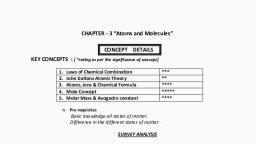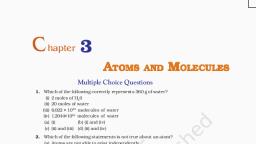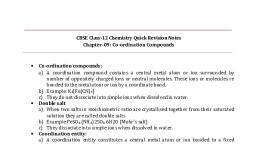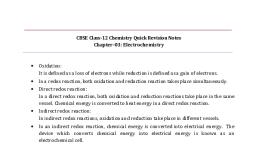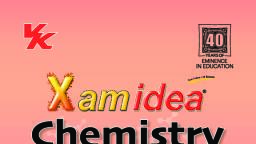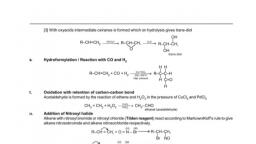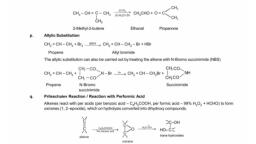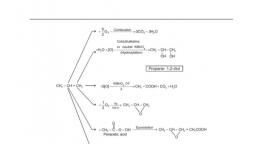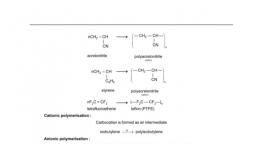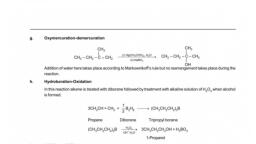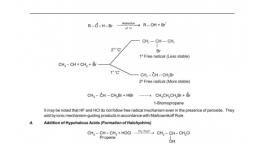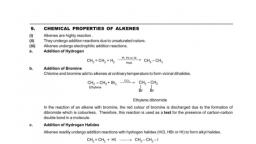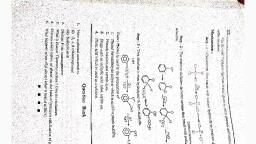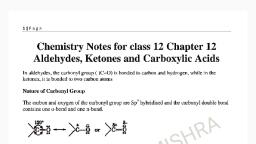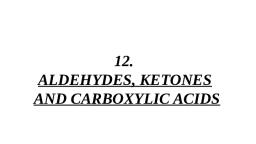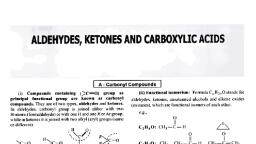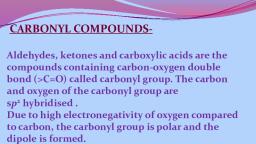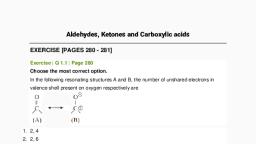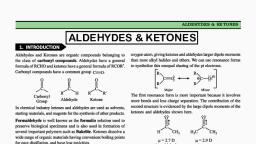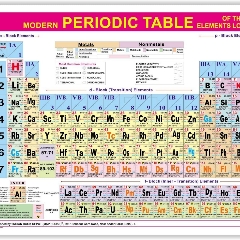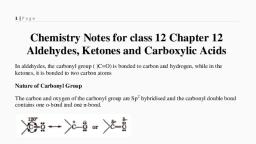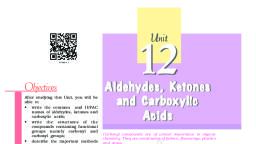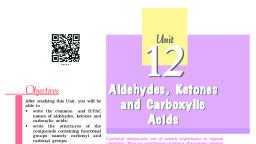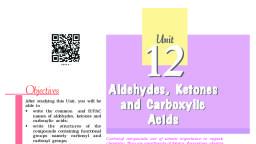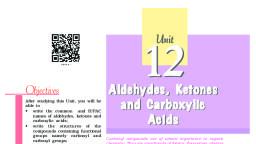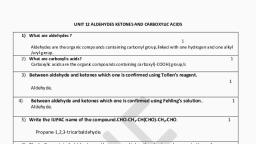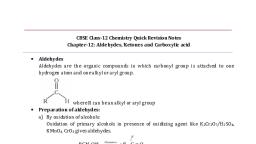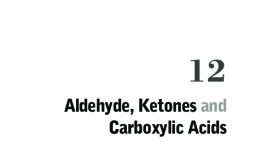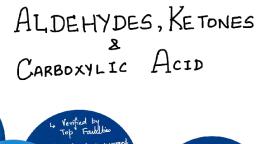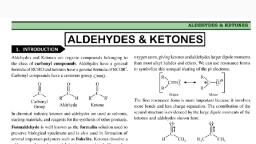Page 1 :
Unit, , 12, Objectives, After studying this Unit, you will be, able to, • write the common and IUPAC, names of aldehydes, ketones and, carboxylic acids;, • write the structures of the, compounds containing functional, groups namely carbonyl and, carboxyl groups;, • describe the important methods, of preparation and reactions of, these classes of compounds;, • correlate physical properties and, chemical reactions of aldehydes,, ketones and carboxylic acids,, with their structures;, • explain the mechanism of a few, selected reactions of aldehydes, and ketones;, • understand, various, factors, affecting the acidity of carboxylic, acids and their reactions;, • describe the uses of aldehydes,, ketones and carboxylic acids., , Aldehydes, Kee tones, Aldehydes,, K, and Carboxylic, A cids, Carbonyl compounds are of utmost importance to organic, chemistry. They are constituents of fabrics, flavourings, plastics, and drugs., , In the previous Unit, you have studied organic, compounds with functional groups containing carbonoxygen single bond. In this Unit, we will study about the, organic compounds containing carbon-oxygen double, bond (>C=O) called carbonyl group, which is one of the, most important functional groups in organic chemistry., In aldehydes, the carbonyl group is bonded to a, carbon and hydrogen while in the ketones, it is bonded, to two carbon atoms. The carbonyl compounds in which, carbonyl group is bonded to oxygen are known as, carboxylic acids, and their derivatives (e.g. esters,, anhydrides) while in compounds where carbon is, attached to nitrogen and to halogens are called amides, and acyl halides respectively. The general formulas of, these classes of compounds are given below:, , 2015-16
Page 2 :
Aldehydes, ketones and carboxylic acids are widespread in plants, and animal kingdom. They play an important role in biochemical, processes of life. They add fragrance and flavour to nature, for example,, vanillin (from vanilla beans), salicylaldehyde (from meadow sweet) and, cinnamaldehyde (from cinnamon) have very pleasant fragrances., , They are used in many food products and pharmaceuticals to add, flavours. Some of these families are manufactured for use as solvents, (i.e., acetone) and for preparing materials like adhesives, paints, resins,, perfumes, plastics, fabrics, etc., , 12.1 Nomenclature and Structure of Carbonyl Group, 12.1.1, Nomenclature, , I. Aldehydes and ketones, Aldehydes and ketones are the simplest and most important carbonyl, compounds., There are two systems of nomenclature of aldehydes and ketones., (a) Common names, Aldehydes and ketones are often called by their common names, instead of IUPAC names. The common names of most aldehydes are, derived from the common names of the corresponding carboxylic, acids [Section 12.6.1] by replacing the ending –ic of acid with aldehyde., At the same time, the names reflect the Latin or Greek term for the, original source of the acid or aldehyde. The location of the substituent, in the carbon chain is indicated by Greek letters α, β, γ, δ, etc. The, α-carbon being the one directly linked to the aldehyde group, βcarbon the next, and so on. For example, , Chemistry 350, , 2015-16
Page 3 :
The common names of ketones are derived by naming two alkyl, or aryl groups bonded to the carbonyl group. The locations of, substituents are indicated by Greek letters, α α′, β β′ and so on, beginning with the carbon atoms next to the carbonyl group,, indicated as αα′. Some ketones have historical common names,, the simplest dimethyl ketone is called acetone. Alkyl phenyl, ketones are usually named by adding the acyl group as prefix to, phenone. For example, , (b) IUPAC names, The IUPAC names of open chain aliphatic aldehydes and ketones, are derived from the names of the corresponding alkanes by, replacing the ending –e with –al and –one respectively. In case of, aldehydes the longest carbon chain is numbered starting from the, carbon of the aldehyde group while in case of ketones the, numbering begins from the end nearer to the carbonyl group. The, substituents are prefixed in alphabetical order along with numerals, indicating their positions in the carbon chain. The same applies to, cyclic ketones, where the carbonyl carbon is numbered one. When, the aldehyde group is attached to a ring, the suffix carbaldehyde, is added after the full name of the cycloalkane. The numbering of, the ring carbon atoms start from the carbon atom attached to the, aldehyde group. The name of the simplest aromatic aldehyde, carrying the aldehyde group on a benzene ring is, benzenecarbaldehyde. However, the common name benzaldehyde, is also accepted by IUPAC. Other aromatic aldehydes are hence, named as substituted benzaldehydes., , 351, , Aldehydes, Ketones and Carboxylic Acids, , 2015-16
Page 5 :
12.1.2 Structure, of the, Carbonyl, Group, , The carbonyl carbon atom is sp2-hybridised and forms three sigma (σ), bonds. The fourth valence electron of carbon remains in its p-orbital, and forms a π-bond with oxygen by overlap with p-orbital of an oxygen., In addition, the oxygen atom also has two non bonding electron pairs., Thus, the carbonyl carbon and the three atoms attached to it lie in the, same plane and the π-electron cloud is above and below this plane. The, bond angles are approximately 120° as expected of a trigonal coplanar, structure (Figure 12.1)., , π, , Fig.12.1 Orbital diagram for the formation of carbonyl group, , The carbon-oxygen double bond is polarised due to higher, electronegativity of oxygen relative to carbon. Hence, the carbonyl, carbon is an electrophilic (Lewis acid), and carbonyl, oxygen, a nucleophilic (Lewis base) centre. Carbonyl, compounds have substantial dipole moments and are, polar than ethers. The high polarity of the carbonyl group, is explained on the basis of resonance involving a neutral, (A) and a dipolar (B) structures as shown., , Intext Questions, 12.1 Write the structures of the following compounds., (i) α-Methoxypropionaldehyde, (iii) 2-Hydroxycyclopentane carbaldehyde, (v) Di-sec. butyl ketone, , 12.2 Preparation of Aldehydes, and Ketones, 12.2.1 Preparation, of, Aldehydes, and, Ketones, , (ii) 3-Hydroxybutanal, (iv) 4-Oxopentanal, (vi) 4-Fluoroacetophenone, , Some important methods for the preparation of aldehydes, and ketones are as follows:, , 1. By oxidation of alcohols, Aldehydes and ketones are generally prepared by oxidation of primary, and secondary alcohols, respectively (Unit 11, Class XII)., 2. By dehydrogenation of alcohols, This method is suitable for volatile alcohols and is of industrial, application. In this method alcohol vapours are passed over heavy, metal catalysts (Ag or Cu). Primary and secondary alcohols give, aldehydes and ketones, respectively (Unit 11, Class XII)., 3. From hydrocarbons, (i) By ozonolysis of alkenes: As we know, ozonolysis of alkenes, followed by reaction with zinc dust and water gives aldehydes,, 353, , Aldehydes, Ketones and Carboxylic Acids, , 2015-16
Page 6 :
ketones or a mixture of both depending on the substitution, pattern of the alkene (Unit 13, Class XI)., (ii) By hydration of alkynes: Addition of water to ethyne in the, presence of H2SO4 and HgSO4 gives acetaldehyde. All other, alkynes give ketones in this reaction (Unit 13, Class XI)., 12.2.2 Preparation, of, Aldehydes, , 1. From acyl chloride (acid chloride), Acyl chloride (acid chloride) is hydrogenated over catalyst, palladium, on barium sulphate. This reaction is called Rosenmund reduction., , 2. From nitriles and esters, Nitriles are reduced to corresponding imine with stannous chloride, in the presence of hydrochloric acid, which on hydrolysis give, corresponding aldehyde., , This reaction is called Stephen reaction., Alternatively,, nitriles, are, selectively, reduced, by, diisobutylaluminium hydride, (DIBAL-H) to imines followed by, hydrolysis to aldehydes:, , Similarly, esters are also reduced to aldehydes with DIBAL-H., , 3. From hydrocarbons, Aromatic aldehydes (benzaldehyde and its derivatives) are prepared, from aromatic hydrocarbons by the following methods:, (i) By oxidation of methylbenzene, Strong oxidising agents oxidise toluene and its derivatives to, benzoic acids. However, it is possible to stop the oxidation at, the aldehyde stage with suitable reagents that convert the methyl, group to an intermediate that is difficult to oxidise further. The, following methods are used for this purpose., (a) Use of chromyl chloride (CrO2Cl2): Chromyl chloride oxidises, methyl group to a chromium complex, which on hydrolysis, gives corresponding benzaldehyde., Chemistry 354, , 2015-16
Page 7 :
This reaction is called Etard reaction., (b) Use of chromic oxide (CrO 3): Toluene or substituted toluene, is converted to benzylidene diacetate on treating with chromic, oxide in acetic anhydride. The benzylidene diacetate can be, hydrolysed to corresponding benzaldehyde with aqueous acid., , (ii) By side chain chlorination followed by hydrolysis, Side chain chlorination of toluene gives benzal chloride, which, on hydrolysis gives benzaldehyde. This is a commercial method, of manufacture of benzaldehyde., , (iii) By Gatterman – Koch reaction, When benzene or its derivative is treated with carbon monoxide, and hydrogen chloride in the presence of anhydrous aluminium, chloride or cuprous chloride, it gives benzaldehyde or substituted, benzaldehyde., , This reaction is known as Gatterman-Koch reaction., 12.2.3 Preparation, of Ketones, , 1. From acyl chlorides, Treatment of acyl chlorides with dialkylcadmium, prepared by the, reaction of cadmium chloride with Grignard reagent, gives ketones., , 355, , Aldehydes, Ketones and Carboxylic Acids, , 2015-16
Page 9 :
12.3 Physical, Properties, , The physical properties of aldehydes and ketones are described as, follows., Methanal is a gas at room temperature. Ethanal is a volatile liquid., Other aldehydes and ketones are liquid or solid at room temperature., The boiling points of aldehydes and ketones are higher than, hydrocarbons and ethers of comparable molecular masses. It is due to, weak molecular association in aldehydes and ketones arising out of the, dipole-dipole interactions. Also, their boiling points are lower than those, of alcohols of similar molecular masses due to absence of intermolecular, hydrogen bonding. The following compounds of molecular masses 58, and 60 are ranked in order of increasing boiling points., , n-Butane, Methoxyethane, Propanal, Acetone, Propan-1-ol, , b.p.(K), , Molecular Mass, , 273, 281, 322, 329, 370, , 58, 60, 58, 58, 60, , The lower members of aldehydes and ketones such as methanal,, ethanal and propanone are miscible with water in all proportions,, because they form hydrogen bond with water., , However, the solubility of aldehydes and ketones decreases rapidly, on increasing the length of alkyl chain. All aldehydes and ketones are, fairly soluble in organic solvents like benzene, ether, methanol,, chloroform, etc. The lower aldehydes have sharp pungent odours. As, the size of the molecule increases, the odour becomes less pungent, and more fragrant. In fact, many naturally occurring aldehydes and, ketones are used in the blending of perfumes and flavouring agents., Arrange the following compounds in the increasing order of their, boiling points:, , Example 12.2, , CH3CH 2CH2 CHO, CH3 CH2 CH2 CH2OH, H5 C2 -O-C2H5 , CH3 CH2 CH2 CH3, , The molecular masses of these compounds are in the range of 72 to, 74. Since only butan-1-ol molecules are associated due to extensive, intermolecular hydrogen bonding, therefore, the boiling point of, butan-1-ol would be the highest. Butanal is more polar than, ethoxyethane. Therefore, the intermolecular dipole-dipole attraction, is stronger in the former. n-Pentane molecules have only weak van, der Waals forces. Hence increasing order of boiling points of the, given compounds is as follows:, , Solution, , CH3 CH2 CH2CH3 < H5C2 -O-C2 H5 < CH3CH2CH2CHO < CH3 CH2CH2CH2 OH, 357, , Aldehydes, Ketones and Carboxylic Acids, , 2015-16
Page 10 :
Intext Question, 12.3 Arrange the following compounds in increasing order of, their boiling points., CH3CHO, CH3CH2OH, CH3OCH3, CH3CH2CH3, , 12.4 Chemical, Reactions, , Since aldehydes and ketones both possess the carbonyl functional, group, they undergo similar chemical reactions., 1. Nucleophilic addition reactions, Contrary to electrophilic addition reactions observed in alkenes (refer, Unit 13, Class XI), the aldehydes and ketones undergo nucleophilic, addition reactions., (i) Mechanism of nucleophilic addition reactions, A nucleophile attacks the electrophilic carbon atom of the polar, carbonyl group from a direction approximately perpendicular to, 2, the plane of sp hybridised orbitals of carbonyl carbon (Fig. 12.2)., The hybridisation of carbon changes from sp2 to sp3 in this process,, and a tetrahedral alkoxide intermediate is produced. This, intermediate captures a, proton from the reaction, medium to give the, electrically neutral product., The net result is addition of, Nu– and H+ across the, carbon oxygen double bond, as shown in Fig. 12.2., , Fig.12.2: Nucleophilic attack on carbonyl carbon, , (ii) Reactivity, Aldehydes are generally more reactive than ketones in, nucleophilic addition reactions due to steric and electronic, reasons. Sterically, the presence of two relatively large, substituents in ketones hinders the approach of nucleophile to, carbonyl carbon than in aldehydes having only one such, substituent. Electronically, aldehydes are more reactive than, ketones because two alkyl groups reduce the electrophilicity of, the carbonyl carbon more effectively than in former., , Example 12.3 Would you expect benzaldehyde to be more reactive or less reactive in, nucleophilic addition reactions than propanal? Explain your answer., , Solution The carbon atom of the carbonyl group of benzaldehyde is less, electrophilic than carbon atom of the carbonyl group present in, propanal. The polarity of the carbonyl, group is reduced in benzaldehyde, due to resonance as shown below and, hence it is less reactive than propanal., , Chemistry 358, , 2015-16
Page 11 :
(iii) Some important examples of nucleophilic addition and, nucleophilic addition-elimination reactions:, (a) Addition of hydrogen cyanide (HCN): Aldehydes, and ketones react with hydrogen cyanide (HCN), to yield cyanohydrins. This reaction occurs very, slowly with pure HCN. Therefore, it is catalysed, by a base and the generated cyanide ion (CN- ), being a stronger nucleophile readily adds to, carbonyl compounds to yield corresponding, cyanohydrin., Cyanohydrins, intermediates., , are, , useful, , synthetic, , (b) Addition of sodium hydrogensulphite: Sodium, hydrogensulphite adds to aldehydes and, ketones to form the addition products., The position of, the equilibrium, lies largely to, the right hand, side for most, aldehydes and to, the left for most, ketones due to steric reasons. The hydrogensulphite addition, compound is water soluble and can be converted back to the, original carbonyl compound by treating it with dilute mineral, acid or alkali. Therefore, these are useful for separation and, purification of aldehydes., 3, , 3, , (c) Addition of Grignard reagents: (refer Unit 11, Class XII)., (d) Addition of alcohols: Aldehydes react with one equivalent of, monohydric alcohol in the presence of dry hydrogen chloride, to yield alkoxyalcohol intermediate, known as hemiacetals,, which further react with one more molecule of alcohol to, give a gem-dialkoxy, compound known as, acetal as shown in the, reaction., Ketones react with, ethylene glycol under, similar conditions to form, cyclic products known as, ethylene glycol ketals., Dry hydrogen chloride, protonates the oxygen of, the carbonyl compounds, and therefore, increases, the electrophilicity of the, carbonyl carbon facilitating, , 359, , Aldehydes, Ketones and Carboxylic Acids, , 2015-16
Page 13 :
reduction] or with hydrazine followed by heating with sodium, or potassium hydroxide in high boiling solvent such as ethylene, glycol (Wolff-Kishner reduction)., , 3. Oxidation, Bernhard Tollens, (1841-1918) was a, Professor of Chemistry, at the University of, Gottingen, Germany., , Aldehydes differ from ketones in their oxidation reactions. Aldehydes, are easily oxidised to carboxylic acids on treatment with common, oxidising agents like nitric acid, potassium permanganate, potassium, dichromate, etc. Even mild oxidising agents, mainly Tollens’ reagent, and Fehlings’ reagent also oxidise aldehydes., , Ketones are generally oxidised under vigorous conditions, i.e.,, strong oxidising agents and at elevated temperatures. Their oxidation, involves carbon-carbon bond cleavage to afford a mixture of carboxylic, acids having lesser number of carbon atoms than the parent ketone., , The mild oxidising agents given below are used to distinguish, aldehydes from ketones:, (i) Tollens’ test: On warming an aldehyde with freshly prepared, ammoniacal silver nitrate solution (Tollens’ reagent), a bright, silver mirror is produced due to the formation of silver metal., The aldehydes are oxidised to corresponding carboxylate anion., The reaction occurs in alkaline medium., , (ii) Fehling’s test: Fehling reagent comprises of two solutions,, Fehling solution A and Fehling solution B. Fehling solution A is, aqueous copper sulphate and Fehling solution B is alkaline, sodium potassium tartarate (Rochelle salt). These two solutions, are mixed in equal amounts before test. On heating an aldehyde, with Fehling’s reagent, a reddish brown precipitate is obtained., Aldehydes are oxidised to corresponding carboxylate anion., Aromatic aldehydes do not respond to this test., , 361, , Aldehydes, Ketones and Carboxylic Acids, , 2015-16
Page 14 :
(iii) Oxidation of methyl ketones by haloform reaction:, Aldehydes and ketones having at least one methyl group, linked to the carbonyl carbon atom (methyl ketones), are oxidised by sodium hypohalite to sodium salts of, corresponding carboxylic, acids having one carbon, atom less than that of, carbonyl compound. The, methyl, group, is, converted to haloform., This oxidation does not, affect a carbon-carbon, double bond, if present, in the molecule., Iodoform reaction with sodium hypoiodite is also used for detection, of CH3CO group or CH3CH(OH) group which produces CH3CO group, on oxidation., , Example 12.4 An organic compound (A) with molecular formula C8H8O forms an, , orange-red precipitate with 2,4-DNP reagent and gives yellow, precipitate on heating with iodine in the presence of sodium, hydroxide. It neither reduces Tollens’ or Fehlings’ reagent, nor does, it decolourise bromine water or Baeyer’s reagent. On drastic oxidation, with chromic acid, it gives a carboxylic acid (B) having molecular, formula C7H6O2. Identify the compounds (A) and (B) and explain the, reactions involved., , Solution (A) forms 2,4-DNP derivative. Therefore, it is an aldehyde or a ketone., Since it does not reduce Tollens’ or Fehling reagent, (A) must be a ketone., (A) responds to iodoform test. Therefore, it should be a methyl ketone., The molecular formula of (A) indicates high degree of unsaturation, yet, it does not decolourise bromine water or Baeyer’s reagent. This indicates, the presence of unsaturation due to an aromatic ring., Compound (B), being an oxidation product of a ketone should be a, carboxylic acid. The molecular formula of (B) indicates that it should, be benzoic acid and compound (A) should, therefore, be a, monosubstituted aromatic methyl ketone. The molecular formula of, (A) indicates that it should be phenyl methyl ketone (acetophenone)., Reactions are as follows:, , Chemistry 362, , 2015-16
Page 15 :
4. Reactions due to a-hydrogen, Acidity of α-hydrogens of aldehydes and ketones: The aldehydes, and ketones undergo a number of reactions due to the acidic nature, of α-hydrogen., The acidity of α-hydrogen atoms of carbonyl compounds is due, to the strong electron withdrawing effect of the carbonyl group and, resonance stabilisation of the conjugate base., , (i) Aldol condensation: Aldehydes and ketones having at least one, α-hydrogen undergo a reaction in the presence of dilute alkali, as catalyst to form β-hydroxy aldehydes (aldol) or β-hydroxy, ketones (ketol), respectively. This is known as Aldol reaction., , The name aldol is derived from the names of the two, functional groups, aldehyde and alcohol, present in the products., The aldol and ketol readily lose water to give α,β-unsaturated, carbonyl compounds which are aldol condensation products, and the reaction is called Aldol condensation. Though ketones, give ketols (compounds containing a keto and alcohol groups),, the general name aldol condensation still applies to the reactions, of ketones due to their similarity with aldehydes., , 363, , Aldehydes, Ketones and Carboxylic Acids, , 2015-16
Page 16 :
(ii) Cross aldol condensation: When aldol condensation is carried, out between two different aldehydes and / or ketones, it is called, cross aldol condensation. If both of them contain α-hydrogen, atoms, it gives a mixture of four products. This is illustrated, below by aldol reaction of a mixture of ethanal and propanal., , Ketones can also be used as one component in the cross aldol, reactions., , 5. Other reactions, (i) Cannizzaro reaction: Aldehydes which do not have an, α-hydrogen atom, undergo self oxidation and reduction, (disproportionation) reaction on heating with concentrated alkali., In this reaction, one molecule of the aldehyde is reduced to, alcohol while another is oxidised to carboxylic acid salt., ∆, , ∆, , Chemistry 364, , 2015-16
Page 17 :
(ii) Electrophilic substitution reaction: Aromatic aldehydes and ketones, undergo electrophilic substitution at the ring in which the carbonyl, group acts as a deactivating and meta-directing group., , Intext Questions, 12.4 Arrange the following compounds in increasing order of their reactivity in, nucleophilic addition reactions., (i) Ethanal, Propanal, Propanone, Butanone., (ii) Benzaldehyde, p-Tolualdehyde, p-Nitrobenzaldehyde, Acetophenone., Hint: Consider steric effect and electronic effect., 12.5 Predict the products of the following reactions:, (i), , (ii), , (iii), , (iv), , 12.5 Uses of, Aldehydes, and Ketones, , In chemical industry aldehydes and ketones are used as solvents,, starting materials and reagents for the synthesis of other products., Formaldehyde is well known as formalin (40%) solution used to preserve, biological specimens and to prepare bakelite (a phenol-formaldehyde, resin), urea-formaldehyde glues and other polymeric products., Acetaldehyde is used primarily as a starting material in the manufacture, of acetic acid, ethyl acetate, vinyl acetate, polymers and drugs., Benzaldehyde is used in perfumery and in dye industries. Acetone and, ethyl methyl ketone are common industrial solvents. Many aldehydes, and ketones, e.g., butyraldehyde, vanillin, acetophenone, camphor, etc., are well known for their odours and flavours., 365, , Aldehydes, Ketones and Carboxylic Acids, , 2015-16
Page 20 :
Carboxylic acids are also prepared from aldehydes by the use of, mild oxidising agents (Section 12.4)., 2. From alkylbenzenes, Aromatic carboxylic acids can be prepared by vigorous oxidation of, alkyl benzenes with chromic acid or acidic or alkaline potassium, permanganate. The entire side chain is oxidised to the carboxyl group, irrespective of length of the side chain. Primary and secondary alkyl, groups are oxidised in this manner while tertiary group is not affected., Suitably substituted alkenes are also oxidised to carboxylic acids, with these oxidising reagents (refer Unit 13, Class XI)., , 3. From nitriles and amides, Nitriles are hydrolysed to amides and then to acids in the presence of, −, , H+ or OH as catalyst. Mild reaction conditions are used to stop the, reaction at the amide stage., , 4. From Grignard reagents, Grignard reagents react with carbon dioxide (dry ice) to form salts of, carboxylic acids which in turn give corresponding carboxylic acids, after acidification with mineral acid., , As we know, the Grignard reagents and nitriles can be prepared, from alkyl halides (refer Unit 10, Class XII). The above methods, Chemistry 368, , 2015-16
Page 22 :
Solution, , (i), , (ii), , (iii), , (iv), , (v), , (vi), , Intext Question, 12.7 Show how each of the following compounds can be, converted to benzoic acid., (i) Ethylbenzene, (ii) Acetophenone, (iii) Bromobenzene, , (iv), , Phenylethene (Styrene), , Chemistry 370, , 2015-16
Page 23 :
12.8 Physical, Properties, , Aliphatic carboxylic acids upto nine carbon atoms are colourless, liquids at room temperature with unpleasant odours. The higher, acids are wax like solids and are practically odourless due, to their low volatility. Carboxylic acids are higher boiling, liquids than aldehydes, ketones and even alcohols of, comparable molecular masses. This is due to more extensive, association of carboxylic acid molecules through, intermolecular hydrogen bonding. The hydrogen bonds are, not broken completely even in the vapour phase. In fact,, In vapour state or in, most carboxylic acids exist as dimer in the vapour phase, aprotic solvent, or in the aprotic solvents., Simple aliphatic carboxylic acids having upto four, carbon atoms are miscible in water due to the formation, of hydrogen bonds with water. The solubility decreases, with increasing number of carbon atoms. Higher, carboxylic acids are practically insoluble in water due to, the increased hydrophobic interaction of hydrocarbon, part. Benzoic acid, the simplest aromatic carboxylic acid, is nearly insoluble in cold water. Carboxylic acids are, Hydrogen bonding of, also soluble in less polar organic solvents like benzene,, RCOOH with H2 O, ether, alcohol, chloroform, etc., , 12.9 Chemical Reactions, 12.9.1 Reactions, Involving, Cleavage of, O–H Bond, , The reaction of carboxylic acids are classified as follows:, , Acidity, Reactions with metals and alkalies, , The carboxylic acids like alcohols evolve hydrogen with electropositive, metals and form salts with alkalies similar to phenols. However, unlike, phenols they react with weaker bases such as carbonates and, hydrogencarbonates to evolve carbon dioxide. This reaction is used to, detect the presence of carboxyl group in an organic compound., , Carboxylic acids dissociate in water to give resonance stabilised, carboxylate anions and hydronium ion., O, R—C, , –, O, , O, +, , + H2O, , H3O + R—C, , OH, , 371, , ≡ R—C –, , R—C, O, –, , O, , O, , O, , Aldehydes, Ketones and Carboxylic Acids, , 2015-16
Page 24 :
For the above reaction:, where Keq, is equilibrium constant and K a is the acid dissociation, constant., For convenience, the strength of an acid is generally indicated by, The, pKa ofrather, hydrochloric, acid, –7.0, where as pK a of trifluoroacetic, its pK, than its, K a is, value., a value, acid (the, strongest, carboxylic, acid),, benzoic acid and acetic acid are, pKa = – log K a, 0.23, 4.19, and 4.76, respectively., Smaller the pKa, the stronger the acid ( the better it is as a proton, donor). Strong acids have pKa values < 1, the acids with pK a values, between 1 and 5 are considered to be moderately strong acids, weak, acids have pK a values between 5 and 15, and extremely weak acids, have pK a values >15., Carboxylic acids are weaker than mineral acids, but they are stronger, acids than alcohols and many simple phenols (pKa is ~16 for ethanol, and 10 for phenol). In fact, carboxylic acids are amongst the most acidic, organic compounds you have studied so far. You already know why, phenols are more acidic than alcohols. The higher acidity of carboxylic, acids as compared to phenols can be understood similarly. The conjugate, base of carboxylic acid, a carboxylate ion, is stabilised by two equivalent, resonance structures in which the negative charge is at the more, electronegative oxygen atom. The conjugate base of phenol, a phenoxide, ion, has non-equivalent resonance structures in which the negative charge, is at the less electronegative carbon atom. Therefore, resonance in, phenoxide ion is not as important as it is in carboxylate ion. Further, the, negative charge is delocalised over two electronegative oxygen atoms in, carboxylate ion whereas it is less effectively delocalised over one oxygen, atom and less electronegative carbon atoms in phenoxide ion (Unit 11,, Class XII). Thus, the carboxylate ion is more stabilised than phenoxide, ion, so carboxylic acids are more acidic than phenols., Effect of substituents on the acidity of carboxylic acids:, Substituents may affect the stability of the conjugate base and thus,, also affect the acidity of the carboxylic acids. Electron withdrawing, groups increase the acidity of carboxylic acids by stabilising the, conjugate base through delocalisation of the negative charge by, inductive and/or resonance effects. Conversely, electron donating groups, decrease the acidity by destabilising the conjugate base., The effect of the following groups in increasing acidity order is, Ph < I < Br < Cl < F < CN < NO2 < CF 3, Thus, the following acids are arranged in order of increasing acidity, (based on pK a values):, CF3COOH > CCl3COOH > CHCl2COOH > NO2CH2COOH > NC-CH2COOH >, , Electron withdrawing group (EWG), stabilises the carboxylate anion, and strengthens the acid, , Electron donating group (EDG), destabilises the carboxylate, anion and weakens the acid, , Chemistry 372, , 2015-16
Page 26 :
Mechanism of esterification of carboxylic acids: The esterification of carboxylic, acids with alcohols is a kind of nucleophilic acyl substitution. Protonation of the, carbonyl oxygen activates the carbonyl group towards nucleophilic addition of the, alcohol. Proton transfer in the tetrahedral intermediate converts the hydroxyl group, +, into – OH2 group, which, being a better leaving group, is eliminated as neutral water, molecule. The protonated ester so formed finally loses a proton to give the ester., , products are gaseous and escape the reaction mixture making the, purification of the products easier., 4. Reaction with ammonia, Carboxylic acids react with ammonia to give ammonium salt which, on further heating at high temperature give amides. For example:, , 1. Reduction, Carboxylic acids are reduced to primary alcohols by lithium, aluminium hydride or better with diborane. Diborane does not easily, , Chemistry 374, , 2015-16
Page 27 :
12.9.3 Reactions, Involving, –COOH, Group, , reduce functional groups such as ester, nitro, halo, etc. Sodium, borohydride does not reduce the carboxyl group., 2. Decarboxylation, Carboxylic acids lose carbon dioxide to form hydrocarbons when their, , sodium salts are heated with sodalime (NaOH and CaO in the ratio of, 3 : 1). The reaction is known as decarboxylation., Alkali metal salts of carboxylic acids also undergo decarboxylation, on electrolysis of their aqueous solutions and form hydrocarbons having, , twice the number of carbon atoms present in the alkyl group of the acid., The reaction is known as Kolbe electrolysis (Unit 13, Class XI)., , 12.9.4, Substitution, Reactions in the, Hydrocarbon Part, , 1. Halogenation, Carboxylic acids having an α-hydrogen are halogenated at the, α-position on treatment with chlorine or bromine in the presence of, small amount of red phosphorus to give α-halocarboxylic acids. The, reaction is known as Hell-Volhard-Zelinsky reaction., 2. Ring substitution, Aromatic carboxylic acids undergo electrophilic substitution reactions, , 375, , Aldehydes, Ketones and Carboxylic Acids, , 2015-16
Page 28 :
in which the carboxyl group acts as a deactivating and meta-directing, group. They however, do not undergo Friedel-Crafts reaction, (because the carboxyl group is deactivating and the catalyst, aluminium chloride (Lewis acid) gets bonded to the carboxyl group)., Methanoic acid is used in rubber, textile, dyeing, leather and electroplating, industries. Ethanoic acid is used as solvent and as vinegar in food industry., , Intext Question, 12.8, , Which acid of each pair shown here would you expect to be stronger?, (i) CH3CO2H or CH2FCO2H, (ii) CH2FCO2H or CH2ClCO2H, (iii) CH2FCH2CH2CO2H or CH3CHFCH2CO2H, (iv), , 12.10 Uses of, Carboxylic, Acids, , Hexanedioic acid is used in the manufacture of nylon-6, 6. Esters of benzoic, acid are used in perfumery. Sodium benzoate is used as a food preservative., Higher fatty acids are used for the manufacture of soaps and detergents., , Summary, Aldehydes, ketones and carboxylic acids are some of the important classes of, organic compounds containing carbonyl group. These are highly polar molecules., Therefore, they boil at higher temperatures than the hydrocarbons and weakly, polar compounds such as ethers of comparable molecular masses. The lower, members are more soluble in water because they form hydrogen bonds with water., The higher members, because of large size of hydrophobic chain of carbon atoms,, are insoluble in water but soluble in common organic solvents. Aldehydes are, prepared by dehydrogenation or controlled oxidation of primary alcohols and, controlled or selective reduction of acyl halides. Aromatic aldehydes may also be, prepared by oxidation of (i) methylbenzene with chromyl chloride or CrO3 in the, presence of acetic anhydride, (ii) formylation of arenes with carbon monoxide and, hydrochloric acid in the presence of anhydrous aluminium chloride, and (iii) cuprous, chloride or by hydrolysis of benzal chloride. Ketones are prepared by oxidation of, secondary alcohols and hydration of alkynes. Ketones are also prepared by reaction, of acyl chloride with dialkylcadmium. A good method for the preparation of aromatic, ketones is the Friedel-Crafts acylation of aromatic hydrocarbons with acyl chlorides, or anhydrides. Both aldehydes and ketones can be prepared by ozonolysis of alkenes., Aldehydes and ketones undergo nucleophilic addition reactions onto the carbonyl, group with a number of nucleophiles such as, HCN, NaHSO3 , alcohols (or diols),, Chemistry 376, , 2015-16
Page 31 :
12.17 Complete each synthesis by giving missing starting material, reagent or products, , 12.18 Give plausible explanation for each of the following:, (i) Cyclohexanone forms cyanohydrin in good yield but 2,2,6-trimethylcyclohexanone does not., (ii) There are two –NH2 groups in semicarbazide. However, only one is involved, in the formation of semicarbazones., (iii) During the preparation of esters from a carboxylic acid and an alcohol in, the presence of an acid catalyst, the water or the ester should be removed, as soon as it is formed., 12.19 An organic compound contains 69.77% carbon, 11.63% hydrogen and rest oxygen., The molecular mass of the compound is 86. It does not reduce Tollens’ reagent, but forms an addition compound with sodium hydrogensulphite and give positive, iodoform test. On vigorous oxidation it gives ethanoic and propanoic acid. Write, the possible structure of the compound., 12.20 Although phenoxide ion has more number of resonating structures than, carboxylate ion, carboxylic acid is a stronger acid than phenol. Why?, Answers to Some Intext Questions, , 12.1, (i), , (iv), , (ii), , (v), , (iii), , (vi), 379, , Aldehydes, Ketones and Carboxylic Acids, , 2015-16


